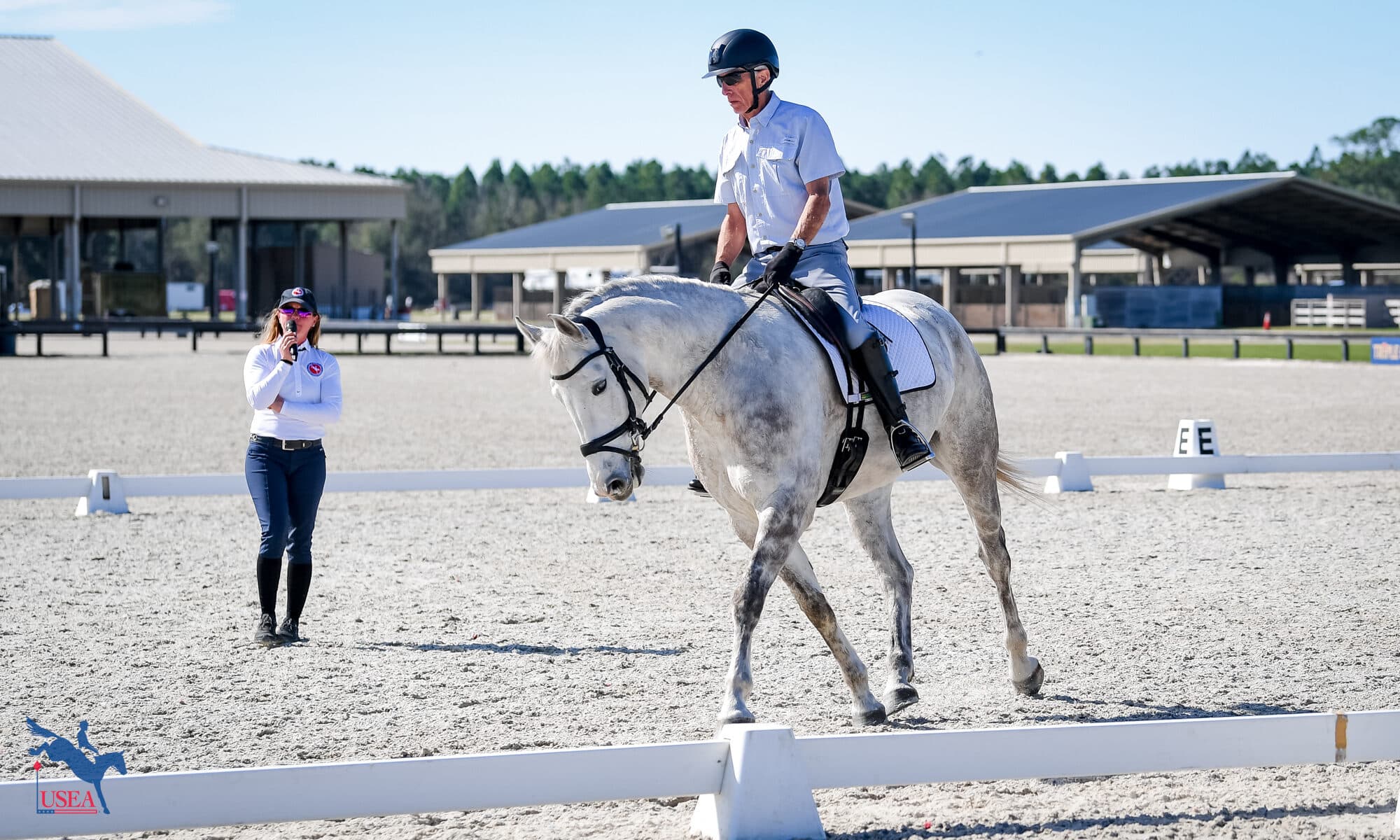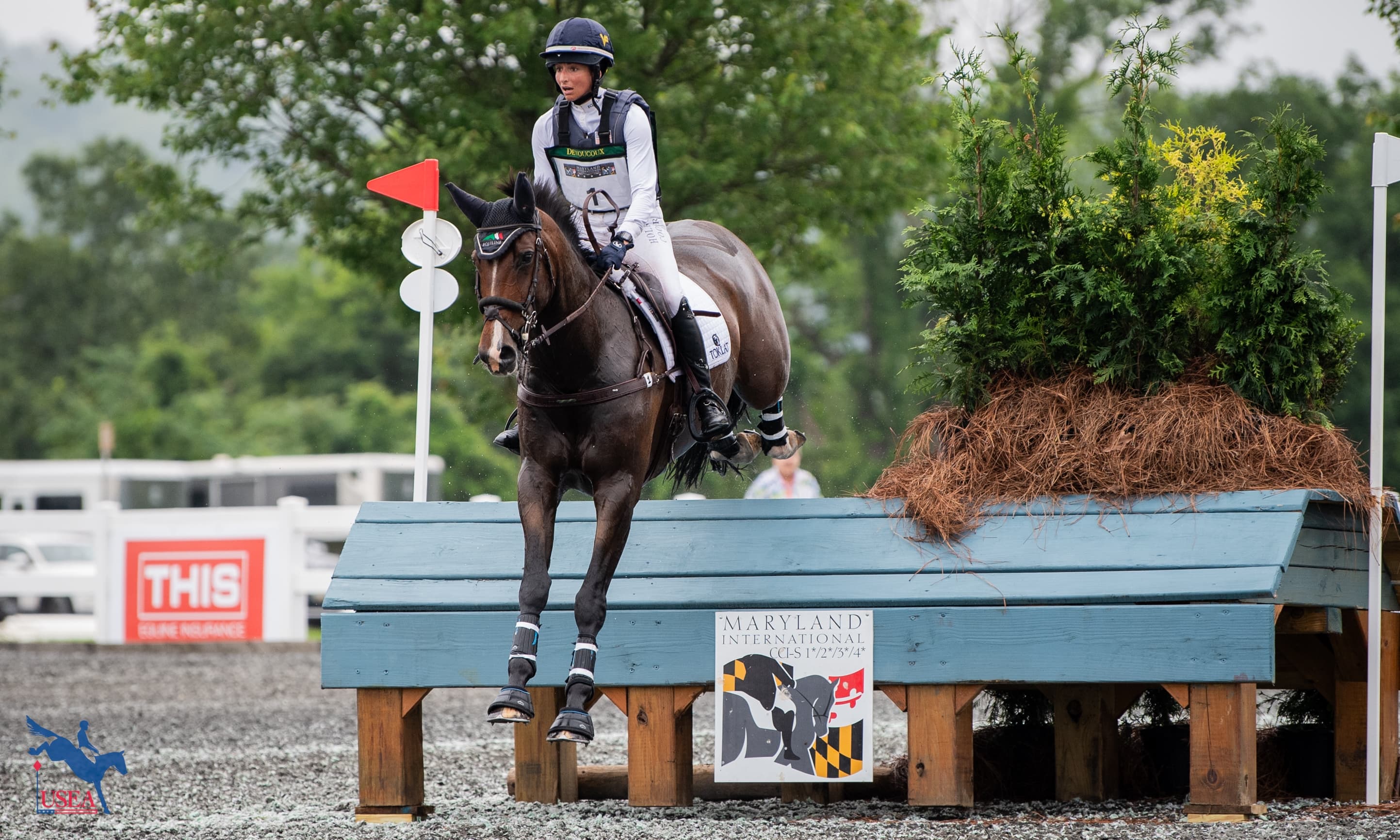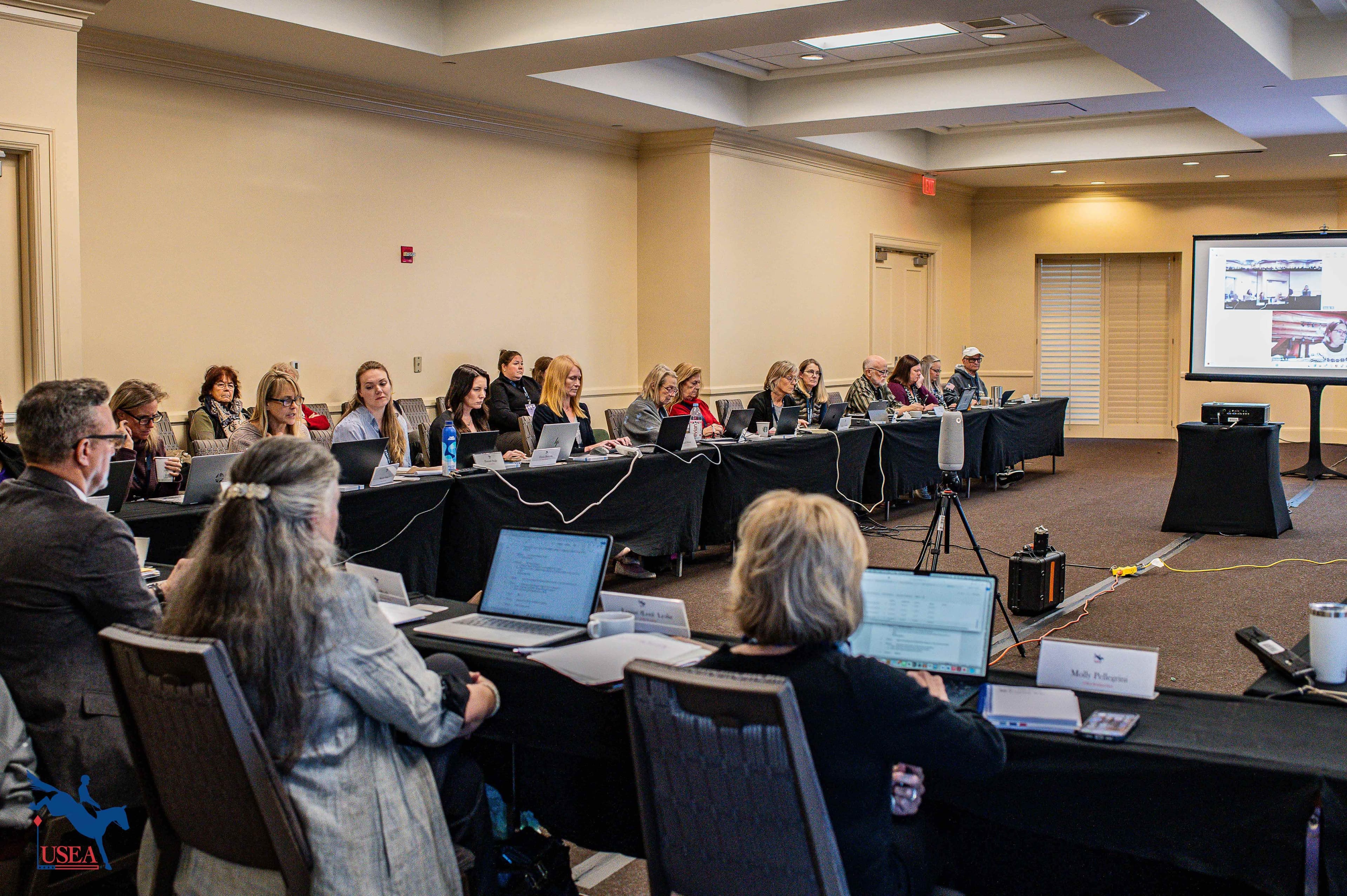Test Tips and Lots of Learning on Day 1 of the 2024 ECP Symposium

Ocala, Fla.—Jan. 30—Nearly 50 participants headed to the Florida Horse Park today for the start of the 2024 USEA Eventing Coaches Program Symposium.
Each day, participants pair up with ECP Faculty members to discuss demo rides, brainstorm ideas, and create lesson plans. They also have the opportunity for question-and-answer sessions with top professionals in the sport.
Dressage judge Peter Gray kicked off Tuesday morning discussing the German training scale (rhythm, relaxation, contact, straightness, impulsion, collection) and what he looks for as a judge. He gave tips for test riding, which he thinks of as almost a different sport than training at home.
“Happy horse equals happy judge, and that’s what it’s all about. I studied longer to become a five-star judge than my neighbor who’s a neurosurgeon,” he said with a laugh. “When I was competing it wasn’t acceptable practice to speak to the judge about your test, and we didn’t have ride-a-tests, we didn’t have trainer-rider symposiums—I thought I knew what the judge was looking for, but really, I didn’t. Now we have a chance to really educate people in what the judge is looking for and how as trainers can we help our students become more successful?”
He noted he sees a lot of short necks, shortness in the gaits, and restriction in the warm-up ring and at clinics, and while some of those techniques might work momentarily in training, “in the test it’s all about putting a smile on and showing the best gaits your horse can show. Judges are looking for and judging for freedom of gaits—no constraint, no restriction. If we see a short neck, then this is not what the judge is looking for. I would encourage you as trainers to really take a look at the final frame your horse is presenting before he goes down centerline.”
The group then moved outside to watch three riders go through a Novice, Training, and Intermediate dressage test while Gray provided commentary.

The first pair, Mary Burke and Valentino, rode through a Novice test. The gelding was a lovely mover but a bit behind the vertical at times. “Behind the vertical, for me, should never exist, especially in competition,” he said. “To have a horse that’s up and behind the vertical, the neck has to be short, and there has to be restriction. Working in a long and low frame, if we add an element of roundness and submission, we call this deep. This is good to get them to relax behind the saddle and swing in their hips.”
At Beginner Novice through Training, he said he’s happy if the poll is the same level as the wither. If the horse has their nose a little ahead of the vertical but the contact with the rider’s hands is steady and confident and showing suppleness and bend, the frame is “perfectly adequate.” Gray said he notices that the short neck is sometimes rewarded at the upper levels, but he’s doing his best to stick to his principles and reward a more correct frame.
Gray emphasized that he tells lower level riders to stay out of the corners.
“They look at me like I have two heads because all of their coaches tell them to do go deep into the corner,” he said. “In training, it’s important for the horse to be confident going into the corner, and any exercises I do with my young horses involves the corner, and it sort of holds their hind quarter and prevents them from swinging outwards. Understand that there’s training and there’s what exercises we do in the warm-up to prepare for the competition.
“With lower-level horses I encourage my students to stay out of the corner and show bend,” he continued. “The further up the levels in competition you go, there’s an expectation of collection and that the horse has the power and balance to go deeper into the corner. But not at Beginner Novice, Novice, and Training. Round off the corner and show bend.”
Gray also looks for hands that are still but not locked. “When the horse is moving at the walk, the biomechanics of the way the horse walks is that his nose is going forward and back,” he said. “Riders that have locked contact can create a horse that’s behind the vertical or short in the neck or make the rhythm of the walk lateral. This connection cannot be snatchy. Follow the motion.”
He described modifiers—for example, if the quality of the trot is a 7 to him, and on a 20-meter circle the horse showed suppleness and flexion, then he might give that movement a 7.5. If the horse was nice and engaged and had impulsion, some judges might go to an 8. Things that affect that gait scores are modifiers.
He reminded the group that the test directives are for the riders to know what the judges are looking for and the criteria of that movement, not for telling the judge how to judge each move.
He also added to make sure that when a rider starts going around the outside of the arena, show what you can do, not what you can’t do. Don’t start schooling movements you’re concerned about that might make for a bad image in the judge’s mind—they’re only human he reminded the group. “The judge is probably looking at the scores from the previous ride, but sometimes you look up and say, ‘Oh that could be a good one.’ ”

The afternoon session was built around observing, analyzing, and planning instruction for three riders of varying levels. Each group worked with an ECP coach to help guide them.
Nicola Tucker rode her “Amish buggy horse” Pandora, showing off their Beginner Novice skills. ECP coach Karen O’Connor’s group noticed her mare looked like she could use some lateral work for suppleness, and Tucker was able to demonstrate a leg yield in trot. O’Connor noted that it was important for coaches to be able to teach more than what’s required in a test.
ECP coach Mary D’Arcy then led Tucker through some exercises her group had come up with including a quarter turn on the forehand in walk. She reminded Tucker to catch Pandora’s outside shoulder as she wanted to fall out.
Repeating one of Gray’s tips, she encouraged Tucker to keep her elbows moving in walk and have a purposeful walk and a plan as to where she wanted to go. The turn on the forehand steps helped with the mare’s difficulty bending right. Once she was responsive to Tucker’s right leg, they worked on bend on a 14-meter circle.
They also worked on a consistent rhythm and less abrupt walk/trot transitions. She had Tucker stay in rising trot as long as possible into the walk transition and focus on softening her hands and elbows, even if it took a quarter of a circle. Then she had Tucker pretend to walk to work on her half halt. Sometimes she wasn’t as tight in her position.
“We noticed in our group that at certain times, your left hand went down here,” she said, asking if Tucker was aware of it. “The first thing you have to ask yourself is, why is the rider doing a certain thing? You have to notice if it’s happening, and Nikki did notice it. The next thing we have to ask her is, what are you trying to do with that hand?”
She suggested that when Pandora fell in to the right, Tucker raise her left hand in an exaggerated way as she went on to a circle. “You can tell the rider to bend their elbow all day, but if you tell the rider to raise their hand, the elbow will bend. Sometimes you have to get to things in a roundabout way,” said D’Arcy.
The small exercises of getting the horse responsive to the inside leg and moving into the outside rein without the rider changing the position of her hands provided a channel for the horse to go, and the trot improved.
“I’m guilty of too much information all at once,” admitted D’Arcy as they took a break. “Sometimes we don’t know what our body is doing. As with all adult amateurs, I believe that you’re trying to do everything as well as you can every second, Nikki. That can work against you. Sometimes you have to let something go a bit to achieve something else.
“Practice for the rider to stay in the moment longer,” she continued. “It doesn’t matter if the horse is looking to the outside momentarily. It matters if the transitions are too abrupt and that’s not getting corrected in the moment; the consistency of the gait we’re in and the shape of the horse going around the figure [is what’s important.] If the horse is not in alignment, you can’t create a situation where the rider can sit better and not get thrown around.”

Connor Giesselman’s dressage horse Valor 11:11 has competed through second level, or the equivalent of Preliminary/Intermediate. After watching her warm up, Robin Walker’s group decided the horse needed to go forward with a longer neck and less collection. They wanted to see a more confident ride from Giesselman.
“Big moving horses can look like they’re on but they’re not always,” said Walker. “They look like they’re doing something, when really you’re sat on pins up there on this super mover, but they’re not really with you.”
Giesselman expressed some concern that “Vinny” likes to buck in canter and can be unpredictable, especially at shows and when working on flying changes, and that she can panic.
Walker encouraged Giesselman to go much more forward in trot and canter than she was as she went around the arena—“You have to trot around looking like Will Coleman’s horse [Chin Tonic HS] for a little bit.”
They worked through forward and back transitions in the trot and canter. Walker emphasized that without Vinny going forward when asked, lateral suppleness and lateral movements wouldn’t happen. He suggested using circles to back the gelding off if Giesselman was feeling like he might misbehave.
He suggested Giesselman come up with a concrete warm up plan before heading back to a show and make sure she’s at least 75 percent confident in it.
O’Connor’s group noted Giesselman was riding behind the vertical when she was unsure but got better as she went along. “At the end, all the parts came together because you gave him a job other than misbehaving,” she said.
Cross-country course builder and designer Jay Hambly finished off the afternoon with a discussion on the basics of cross-country fence construction for a schooling field.
The group will head out to cross-country tomorrow after a discussion with Dr. Paul Haefner at 8 a.m
This coverage is brought to you by:

Helpful Links:
- ECP Symposium Fast Facts
- ECP Homepage
- Event Coverage
- Upcoming ECP Workshops and Assessments
- Directory of ECP Certified Coaches
- ECP Certification Information
Don't forget to follow the USEA event coverage on social media!
About the USEA Eventing Coaches Program (ECP)
Coaches are essential to the training of riders and horses for safe and educated participation in the sport of eventing. The USEA Eventing Coaches Program (ECP), formerly known as the Instructors’ Certification Program (ICP), was initiated in 2002 to educate all levels of eventing coaches with crucial training principles upon which they can continue to build throughout their teaching careers. ECP offers educational workshops and assessments by which both regular coaches, Level I through Level V, Young Event Horse (YEH) coaches, and Young Event Horse professional horse trainers can become ECP certified. Additional information about ECP’s goals, benefits, workshops, and assessments as well as names and contact information for current ECP certified coaches, YEH coaches, and YEH professional horse trainers are available on the USEA website. Click here to learn more about the USEA Eventing Coaches Program.
The USEA would like to thank Parker Equine Insurance, the United States Pony Clubs, and Strider for their support of the Eventing Coaches Program.


































